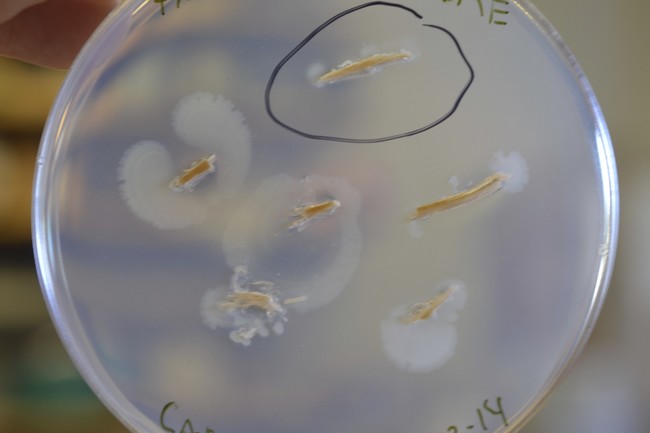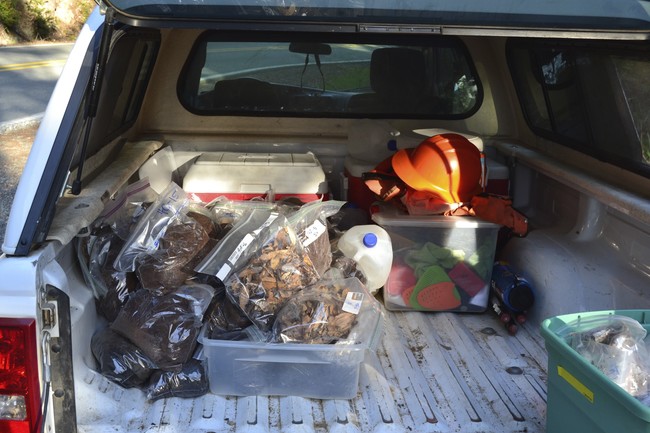Citizen science can be a highly valuable way to engage the public in research and generate a quantity and quality of data that otherwise wouldn't be feasible. While some projects draw on a highly informed amateur mycologist community and others other aim to inform/engage a more general public, the kinds of projects mentioned in this post help to bridge the gaps between researchers and the public while contributing to fungal conservation and monitoring programs.
New and developing initiatives:
Discovering Plant Destroyers in South Africa with Citizen Science - Forestry and Biotechnology Institute (FABI), University of Pretoria (Joey Hulbert)
 |
| Cultures growing from plant tissue [photo - J. Hulbert] |
This project seeks to discover new species of
Phytophthora in the forests of South Africa while engaging the public in the science process.
Phytophthora is a genus of major plant pathogens (not ~technically~ a fungus, yes, I know) responsible for Sudden Oak Death (
P. ramorum) and many other diseases across a wide range of plants. This project focuses on the forest diseases and aims to document unknown
Phytophthora species sourced from leaf/soil/water samples collected by volunteers. Through workshops and the recruitment/training of volunteers, Joey hopes to increase access to science in underserved communities.
I'm listing this project first because there is less than two weeks left to
donate to Joey's experiment.com page (this stage of fundraising ends April 23). [Update: funded!]
 |
| The post-sampling haul [photo - J. Hulbert} |
Read more about the project and donate here!
The Lost & Found Fungi Project - Royal Botanic Gardens, Kew
This project aims to join the mycology team at RBG Kew and the knowledgeable non-professional mycologists of Britain to assess the conservation status of rarely reported fungal species. The long history of British naturalists and their particular record-keeping habits give the project a starting point for identifying the species with a low or decreasing number of reports and sites, and the large number of mycological societies and individual naturalists with an interest in mycology form a preexisting highly knowledgeable network of volunteers.
 |
| Paul Cannon (RGB Kew mycology dept) photographs Xenotypa aterrima during a survey for Dencoeliopsis johnstonii, a small discoid fungus that grows on/with X. aterrima. |
This project has been funded by the Esmee Fairbairn Foundation and is just getting off the ground as I write this.
 |
| Brian Douglas (project coordinator) inspects a fungarium specimen of an Ustilago species. |
For those interested, the work flow of this project is approximately as follows:
1. Identification of target species that are either genuinely rare or simply underreported
2. Identification and recruitment of volunteer groups and individuals to be part of the L&F network
3. Mapping of current and historical recording sites of each species using RGB Kew's fungarium records and FRDBI records
4. Creation of info sheets that include description, sites, photos, and other information for public dissemination
5. Surveys or requests (timed seasonally) for targeted surveys by people/groups located in regions with historic records to give both positive and negative records
6. Processing of received samples of putative targets
7. Assessment of "true" rareness of species and assessment of vulnerability level of habitat
8 . Formation of surveillance plans and conservation plans for truly rare and threatened species
 |
| The historical collections of Hypocreopsis lichenoides. The fungarium (fungal herbarium) at RGB Kew is the largest in the world and contains thousands upon thousands of collections representing species from around the globe. Each preserved and documented specimen is a unique historical record. Some contain photographs, microscope slides, handwritten letters. The red folder indicates the specimen contained within may be the "type specimen," the collection from which the original species description is derived. |
Learn more about the target species and the Lost & Found Fungi Project at their website, and follow them on
Twitter!
Part of my love of projects that increase access to and involvement in biodiversity projects stems from a small fungal diversity survey that was included in Dr. Ann Willyard's "Algae & Fungi" course that I took at Hendrix College during undergrad. This project (and getting the Watson, of course) was part of what made me shift my approach to mycology from a hobby to an academic pursuit. That said, part of the power of citizen science is that it can give people with scientific and naturalistic tendencies but no wish to join academia access to resources and impactful outputs.
So, to any undergrad profs out there: contribute to your region's documentation of fungal diversity, give hands-on direction of collecting/vouchering/barcoding fungi, and encourage young mycologists with similar projects!
(The class produced a tiny publication discussing the process and results of the project which might be helpful to anyone seeking to develop and improve on similar projects-
Harrington et al. 2015. Sampling local fungal diversity in an undergraduate laboratory using DNA barcoding. Journal of the Arkansas Academy of Science 68: 65-72)
Other past or ongoing fungal citizen science projects:
FungiMap.org - Putting Australian fungi on the map
"The major activity of Fungimap is a community-based mapping scheme. With the help of many volunteer observers across Australia, from professionals to amateurs, Fungimap aims to map the distribution of 125 target species of Australian fungi. These target species have been chosen so as to be reasonably easy to identify by amateurs in the field, and are generally wide-spread; you can find species descriptions of the first 100 species chosen in the Fungimap field guide Fungi Down Under. Becoming involved in Fungimap is a very good way to gain an introduction to the world of fungi."
Sudden Oak Death Blitz - University of California, Berkeley
"SOD-blitzes inform and educate the community about Sudden Oak Death, get locals involved in detecting the disease, and produce detailed local maps of disease distribution. The map can then be used to identify those areas where the infestation may be mild enough to justify proactive management. "
North American Mycoflora Project (and other countries' mycoflora development) - North American Mycological Association
Mycoflora are comprehensive, updated lists of the fungal diversity of a region. This list can be derived from herbarium specimens and mycological forays. The challenge is that all collections, in addition to being identified, need to be vouchered (preserved and kept in a herbarium) and ideally sequenced to be valid. Funding is a bit of an obstacle. For a real description of the problem and the possible solutions, read
this article.
To an extent, websites like
MushroomObserver.org and other species reporting websites are forms of citizen science as they do form a record of species distribution. The problem is that often the photos and identifications are of low quality, and more importantly, the report has no voucher. I've been guilty of this as well--with no way to legally send collections home, I had to settle for a vague ID and photo. What can ya do sometimes.
If anyone knows of other fungal (or fungus-like organism) "crowdsourcing"/"citizen science" project, send me a message to expand the post.



.jpeg)





















